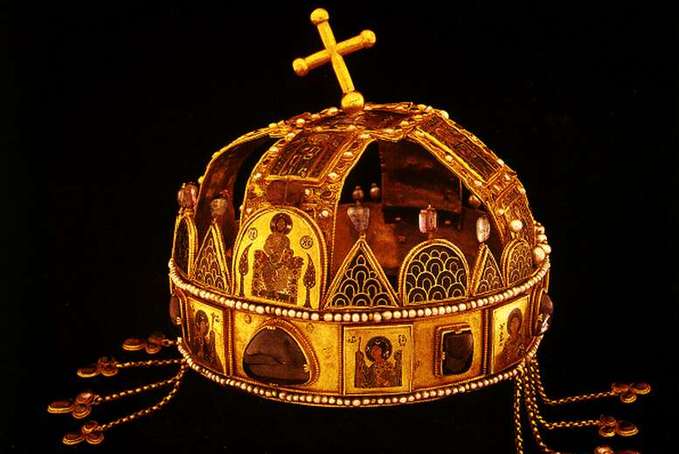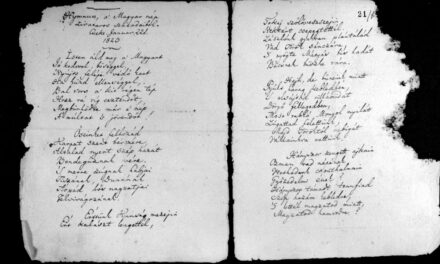According to the mythology of the Holy Crown, "Our country, since our first king, Saint Stephen, is the country of the Mother of God, the Virgin Mary, the Regnum Marianum." (Quoting Dante: the land of the saints, Sacra Pannonia.)
Ever since King St. István offered the Holy Crown, symbolizing the state and all the people living here, to the Holy Virgin, on August 15, 1038, on the feast of Our Lady. According to tradition, the Virgin Mary accepted this offering. In addition to the crown, King St. István also received from the Pope the right of apostolic legation (legatio sedis apostolicae), which also served as the basis for the exercise of his ecclesiastical power.
The sacred offering is also the reason why the Hungarian king is the only apostolic king in the world, or more precisely, he himself is the apostle of the only archregnum in Europe.... The Holy Crown is not only a sacred, mystical object, the crown of the country, but also a person, an independent (public) person. With its independent personality, the crown expresses the sovereignty of the person who owns it. The owner of the crown, as a result of the offering, is definitely the Virgin Mary. The crown belongs to the Virgin Mary, therefore in Hungary the Holy Virgin is sovereign. Through him, the Creator and divine transcendence are sovereign. this is how Hungary is the Regnum Marianum, the Country of Mary."
The doctrine of the Holy Crown leads from mythology to the world of public law, according to which the Holy Crown is the embodiment and symbol of the supreme power of the state , the body of which is made up of the nation and the king, as members and head of the Holy Crown. The original source of power is the nation, which in ancient times entrusted the Holy Crown with the full power, and which alone exercises the power of the Holy Crown in the event that the exercise of royal power becomes impossible. The textbook of the Public Service University conveys the following interpretation of history and constitutional history to its students:
"The ruler exercises his power on behalf of the nation and is responsible to the nation. The Hungarian nobility represented the nation with proud self-awareness, but in a certain sense also the subjugated "people". The public law situation of the country, the constitution, the power transfer agreement between the king and the nation were expressed in a unique way in Hungary by the doctrine of the Holy Crown . The main Hungarian state power belongs to the Holy Crown, and only in possession of it to the king. In other words, the royal rights exercised by the king ipso jure are only vested by the Holy Crown. (For example, Róbert Károly only became a fully legitimate Hungarian king when the Archbishop of Esztergom crowned him with the Holy Crown.) From all this, it followed that the crown is a symbol of the unity of the political nation participating in public life. This actually corresponds to the principle of modern constitutionalism, which gives sovereignty to the whole nation". The radical constitutional reform established by the laws of April 1848 made all citizens of the country members of the Holy Crown with equal rights and thus opened a new chapter of constitutionalism in accordance with the principles of the latest era in the spirit of and keeping the doctrine of the Holy Crown valid until 1944. The latter is already the world of historical public law...
"Regnum Marianum (the Country of Mary), the usual Catholic designation of Hungary since Saint László; its starting point is King St. István's offer of the kingdom to the Virgin Mary, before his death. The respect that existed in the first centuries of the kingdom (Mary's money, flags, churches, poems, legends) reached its peak in education in the Baroque era under the leadership of the Jesuits, when the first Marian congregations were formed" (Catholic religious zealous associations. Z.Zs..) This is what the Új Idők lexicon published in 1941 says, while the best Hungarian lexicon published at the beginning of the century, Pallas, does not have such a title.
The 1961 encyclopedia of the era of communist autocracy, the Új Magyar Lexikon, mentions it as follows: "During the Counter-Reformation (especially in the 18th century), the idea of the state developed by the Jesuits, according to which Hungary was offered by István I to Szűz Mária, who thus became the country's protector and even its actual ruler. On the one hand, the Catholic religion's claim to sovereignty and, on the other hand, the supernaturalism of the royal power were based on this. In the idea of Regnum Marianum, the alliance between counter-reformation Habsburg absolutism and the Hungarian feudal ruling class was expressed. It was revived again during the counter-revolutionary Horthy regime.”
Even from this you can see how much it is an idea that can be examined from different points of view and can be judged differently, rightly and wrongly, depending on one's worldview. With some sense of history and public law, you can immediately tell: this teaching is exceptionally significant from both a religious and a national point of view.
The Regnum Marianum, as a mature idea, in the XVII. appears in the works of Istvánffy, Pázmány, Kopcsányi, Inchoffer in the 19th century, relying on the tenets of the idea of Patrona Hungariae, which expresses the independence of the Hungarian king from external powers but from the orders, according to which the Hungarian kings and the country enjoy the special protection of the Mother of God since Saint Stephen offered his country to the To the Holy Virgin.












